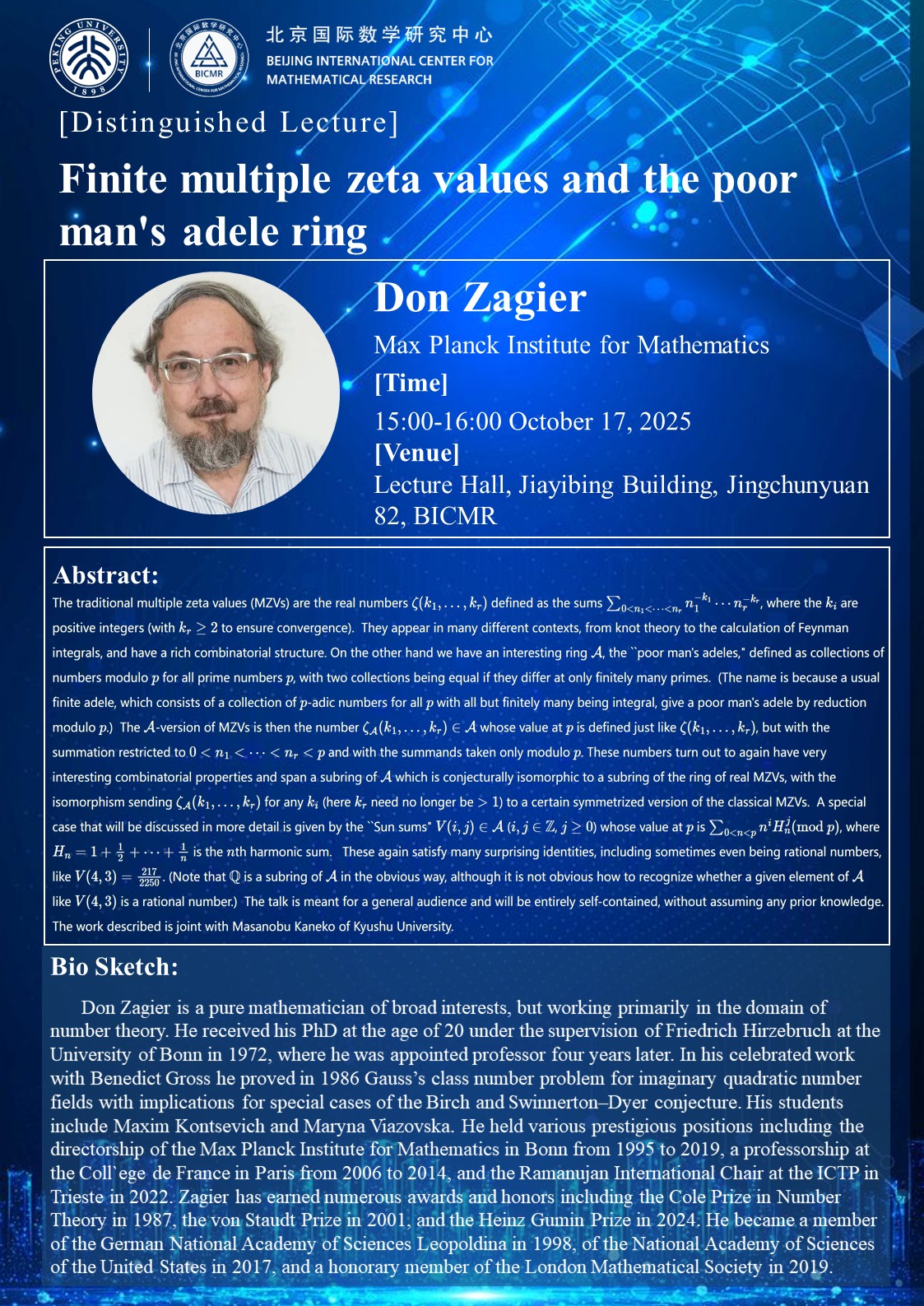[Distinguished Lecture] Finite multiple zeta values and the poor man's adele ring
主讲人: Don Zagier (Max Planck Institute for Mathematics)
活动时间: 从 2025-10-17 15:00 到 16:00
场地: 北京国际数学研究中心,镜春园82号甲乙丙楼报告厅
Abstract:
The traditional multiple zeta values (MZVs) are the real numbers $\zeta(k_1,\dots,k_r)$ defined as the sums $\sum_{0<n_1<\cdots<n_r} n_1^{-k_1}\cdots n_r^{-k_r}$, where the $k_i$ are positive integers (with $k_r\ge2$ to ensure convergence). They appear in many different contexts, from knot theory to the calculation of Feynman integrals, and have a rich combinatorial structure. On the other hand we have an interesting ring $\mathcal A$, the ``poor man's adeles," defined as collections of numbers modulo $p$ for all prime numbers $p$, with two collections being equal if they differ at only finitely many primes. (The name is because a usual finite adele, which consists of a collection of $p$-adic numbers for all $p$ with all but finitely many being integral, give a poor man's adele by reduction modulo $p$.) The $\mathcal A$-version of MZVs is then the number $\zeta_{\mathcal A}(k_1,\dots,k_r)\in\mathcal A$ whose value at $p$ is defined just like $\zeta(k_1,\dots,k_r)$, but with the summation restricted to $0<n_1<\dots<n_r<p$ and with the summands taken only modulo $p$. These numbers turn out to again have very interesting combinatorial properties and span a subring of $\mathcal A$ which is conjecturally isomorphic to a subring of the ring of real MZVs, with the isomorphism sending $\zeta_{\mathcal A}(k_1,\dots,k_r)$ for any $k_i$ (here $k_r$ need no longer be $>1$) to a certain symmetrized version of the classical MZVs. A special case that will be discussed in more detail is given by the ``Sun sums" $V(i,j)\in\mathcal A$ ($i,j\in\Bbb Z$, $j\ge0$) whose value at $p$ is $\sum_{0<n<p}n^iH_n^j \text{(mod $p$)}$, where $H_n=1+\frac12+\cdots+\frac1n$ is the $n$th harmonic sum. These again satisfy many surprising identities, including sometimes even being rational numbers, like $V(4,3)=\frac{217}{2250}$. (Note that $\Bbb Q$ is a subring of $\mathcal A$ in the obvious way, although it is not obvious how to recognize whether a given element of $\mathcal A$ like $V(4,3)$ is a rational number.) The talk is meant for a general audience and will be entirely self-contained, without assuming any prior knowledge. The work described is joint with Masanobu Kaneko of Kyushu University.
Don Zagier is a pure mathematician of broad interests, but working primarily in the domain of number theory. He received his PhD at the age of 20 under the supervision of Friedrich Hirzebruch at the University of Bonn in 1972, where he was appointed professor four years later. In his celebrated work with Benedict Gross he proved in 1986 Gauss’s class number problem for imaginary quadratic number fields with implications for special cases of the Birch and Swinnerton–Dyer conjecture. His students include Maxim Kontsevich and Maryna Viazovska. He held various prestigious positions including the directorship of the Max Planck Institute for Mathematics in Bonn from 1995 to 2019, a professorship at the Coll`ege de France in Paris from 2006 to 2014, and the Ramanujan International Chair at the ICTP in Trieste in 2022. Zagier has earned numerous awards and honors including the Cole Prize in Number Theory in 1987, the von Staudt Prize in 2001, and the Heinz Gumin Prize in 2024. He became a member of the German National Academy of Sciences Leopoldina in 1998, of the National Academy of Sciences of the United States in 2017, and a honorary member of the London Mathematical Society in 2019.



